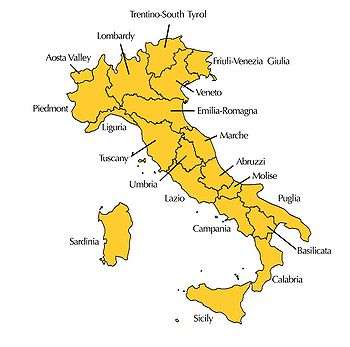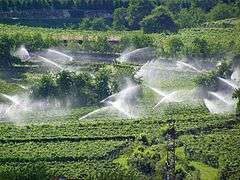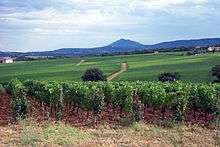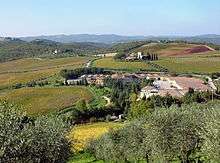Italian wine

Italy is home to some of the oldest wine-producing regions in the world, and Italian wines are known worldwide for their broad variety. Italy, closely followed by France, is the world’s largest wine producer by volume. Its contribution is about 45–50 million hl per year, and represents about ⅓ of global production.[1] Italian wine is exported around the world and is also extremely popular in Italy: Italians rank fifth on the world wine consumption list by volume with 42 litres per capita consumption. Grapes are grown in almost every region of the country and there are more than one million vineyards under cultivation.
Etruscans and Greek settlers produced wine in Italy before the Romans started their own vineyards in the 2nd century BC. Roman grape-growing and winemaking was prolific and well-organized, pioneering large-scale production and storage techniques like barrel-making and bottling.[2]
History
Although vines had been cultivated from the wild Vitis vinifera grape for millennia, it wasn't until the Greek colonization that wine-making flourished. Viticulture was introduced into Sicily and southern Italy by the Mycenaean Greeks,[3] and was well established when the extensive Greek colonization transpired around 800 BC.[4][5] It was during the Roman defeat of the Carthaginians (acknowledged masters of wine-making) in the 2nd century BC that Italian wine production began to further flourish. Large-scale, slave-run plantations sprang up in many coastal areas and spread to such an extent that, in AD 92, emperor Domitian was forced to destroy a great number of vineyards in order to free up fertile land for food production.
During this time, viticulture outside of Italy was prohibited under Roman law. Exports to the provinces were reciprocated in exchange for more slaves, especially from Gaul where trade was intense, according to Pliny, due to the inhabitants being besotted with Italian wine, drinking it unmixed and without restraint.[6] It was customary to mix wine with a good proportion of water which may otherwise have been unpalatable, making wine drinking a fundamental part of early Italian life.
As the laws on provincial viticulture were relaxed, vast vineyards began to flourish in the rest of Europe, especially Gaul (present day France) and Hispania. This coincided with the cultivation of new vines, like biturica (ancestor of the Cabernets). These vineyards became hugely successful, to the point that Italy ultimately became an import centre for provincial wines.[2]
Depending on the vintage, modern Italy is the world's largest or second largest wine producer. In 2005, production was about 20% of the global total, second only to France, which produced 26%. In the same year, Italy's share in dollar value of table wine imports into the U.S. was 32%, Australia's was 24%, and France's was 20%. Along with Australia, Italy's market share has rapidly increased in recent years.[7]
Italian appellation system
In 1963, the first official Italian system of classification of wines was launched. Since then, several modifications and additions to the legislation have been made (a major one in 1992), the last of which, in 2010, has established four basic categories, which are consistent with the last EU regulation in matter of wine (2008–09). The categories, from the bottom level to the top one, are:
- Vini (Wines - informally called 'generic wines'): These are wines that can be produced anywhere in the territory of the EU; no indication of geographical origin, of the grape varieties used, or of the vintage is allowed on the label. (The label only reports the color of the wine.)
- Vini Varietali (Varietal Wines): These are generic wines that are made either mostly (at least 85%) from one kind of authorized 'international' grapes (Cabernet Franc, Cabernet Sauvignon, Chardonnay, Merlot, Sauvignon blanc, Syrah) or entirely from two or more of them. The grape(s) and the vintage can be indicated on the label. (The prohibition to indicate the geographical origin is instead maintained. These wines can be produced anywhere in the territory of the EU.)
- Vini IGP (Wines with Protected Geographical Indication): This category (also traditionally implemented in Italy as IGT - Typical Geographical Indication) is reserved to wines produced in a specific territory within Italy and following a series of specific and precise regulations on authorized varieties, viticultural and vinification practices, organoleptic and chemico-physical characteristics, labeling instructions, etc. Currently (2016) there exist 118 IGPs/IGTs.
- Vini DOP (Wines with Protected Designation of Origin): This category includes two sub-categories, i.e. Vini DOC (Controlled Designation of Origin) and Vini DOCG (Controlled and Guaranteed Designation of Origin). DOC wines must have been IGP wines for at least 5 years. They generally come from smaller regions, within a certain IGP territory, that are particularly vocated for their climatic and geological characteristics and for the quality and originality of the local winemaking traditions. They also must follow stricter production regulations than IGP wines. A DOC wine can be promoted to DOCG if it has been a DOC for at least 10 years. In addition to fulfilling the requisites for DOC wines (since that's the category they come from), before commercialization DOCG wines must pass stricter analyses, including a tasting by a specifically appointed committee. DOCG wines have also demonstrated a superior commercial success. Currently (2016) there exist 332 DOCs and 73 DOCGs for a total of 405 DOPs.
A number of sub-categories also exist regulating the production of sparkling wines (e.g. Vino Spumante, Vino Spumante di Qualità, Vino Spumante di Qualità di Tipo Aromatico, Vino Frizzante).
Within the DOP category, 'Classico' is a wine produced in the historically oldest part of the protected territory. 'Superiore' is a wine with at least 0.5 more alc%/vol than its correspondent regular DOP wine and produced using a smaller allowed quantity of grapes per hectare, generally yielding a higher quality. 'Riserva' is a wine that has been aged for a minimum period of time, depending on the typology (red, white, Traditional-method sparkling, Charmat-method sparkling). Sometimes, 'Classico' or 'Superiore' are themselves part of the name of the DOP (e.g. Chianti Classico DOCG or Soave Superiore DOCG).
The Italian Ministry of Agriculture (MIPAAF) regularly publishes updates to the official classification.[8][9]
It is important to remark that looser regulations do not necessarily correspond to lower quality. In fact, many IGP wines are actually top level products, mainly due to the special skills of their producers (e.g. so called "Super Tuscan" wines are generally IGP wines, but there are also several other IGP wines of superior quality).
Unlike France, Italy has never had an official classification of its best 'crus'. Private initiatives like the Comitato Grandi Cru d'Italia (Committee of the Grand Crus of Italy) and the Instituto del Vino Italiano di Qualità—Grandi marchi (Institute of Quality Italian Wine—Great Brands) each gather a selection of renowned top Italian wine producers, in an attempt to unofficially represent the Italian wine excellence.
In 2007 the Barbaresco Consorzio was the first to introduce the Menzioni Geografiche Aggiuntive (additional geographic mentions) also known as MEGA or subzones; there were 65 subzones vineyard areas, with one more approved in 2010 which brought the final number to 66.[10] The main goal was to put official boundaries to some of the most storied crus in order to protect them from unjustified expansion and exploitation.[10]
The Barolo Consorzio followed suit in 2010 with 181 MEGA, of which 170 were vineyard areas and 11 were village designations.[10] Following the introductions of MEGA for Barbaresco and Barolo the term Vigna (Italian for vineyard) can be used on labels after its respective MEGA and only if the vineyard is within one of the approved official geographic mentions.[10] The official introduction of subzones is strongly advocated by some for different denominations, but so far Barolo and Barbaresco are the only ones to have them.[11]
Geographical characteristics

Important wine-relevant geographic characteristics of Italy include:
- The extensive latitudinal range of the country permits wine growing from the Alps in the north to almost-within-sight of Africa in the south;
- The fact that Italy is a peninsula with a long shoreline contributes moderating climate to coastal wine regions;
- The extensive mountains and foothills provide many altitudes for grape growing and a variety of climate and soil conditions.
Italian wine regions
Italy's twenty wine regions correspond to the twenty administrative regions. Understanding of Italian wine becomes clearer with an understanding of the differences between each region; their cuisines reflect their indigenous wines, and vice versa. The 73 DOCG wines are located in 15 different regions but most of them are concentrated in Piedmont, Veneto and Tuscany. Among these are appellations appreciated and sought after by wine lovers around the world: Barolo, Barbaresco, and Brunello di Montalcino (colloquially known as the "Killer B's"). Other notable wines that in the latest years gain much attention in the international markets and among specialists are: Amarone della Valpolicella, Prosecco di Conegliano- Valdobbiadene, Taurasi from Campania, Franciacorta sparkling wines from Lombardy; evergreen wines are Chianti and Soave, while new wines from the Centre and South of Italy are quickly gaining recognition: Verdicchio, Sagrantino, Primitivo, Nero D'Avola among others. The Friuli-Venezia Giulia is world-famous for the quality of her white wines, like Pinot Grigio. Special sweet wines like Passitos and Moscatos, made in different regions, are also famous since old time.
The regions are, roughly from Northwest to Southeast:


- Aosta Valley
- Piemonte
- Liguria
- Lombardia
- Trentino-Alto Adige/Südtirol
- Friuli-Venezia Giulia
- Veneto
- Emilia-Romagna
- Toscana
- Marche
- Umbria
- Lazio
- Sardinia
- Abruzzo
- Molise
- Campania
- Basilicata
- Puglia
- Calabria
- Sicily
Italian grape varieties
Italy's Ministry of Agriculture and Forestry (MIPAAF), has documented over 350 grapes and granted them "authorized" status. There are more than 500 other documented varieties in circulation as well. The following is a list of the most common and important of Italy's many grape varieties.
Bianco (White)
- Arneis: A variety from Piedmont, which has been grown there since the 15th century.
- Catarratto: Common in Sicily—this is the most widely planted white variety in Salaparuta.
- Fiano: Grown on the southwest coast of Italy.
- Friulano: A variety also known as Sauvignon Vert or Sauvignonasse, it yields one of the most typical wines of Friuli. The wine was previously known as Tocai but the name was changed by the EC to avoid confusion with the Tokay dessert wine from Hungary.
- Garganega: The main grape variety for wines labeled Soave, this is a dry white wine from the Veneto wine region of Italy. It is popular in northeast Italy around the city of Verona. Currently, there are over 3,500 distinct producers of Soave.
- Greco di Tufo: Grown on the southwest coast of Italy.
- Malvasia bianca: A white variety that occurs throughout Italy with many clones and mutations.
- Moscato blanc: Grown mainly in Piedmont, it is mainly used in the slightly-sparkling (frizzante), semi-sweet Moscato d'Asti. Not to be confused with Moscato Giallo and Moscato rosa, two Germanic varietals that are grown in Trentino Alto-Adige.
- Nuragus: An ancient Sardinian variety found in southern Sardegna, producing light and tart wines consumed as an apertifs.
- Passerina: mainly derives from Passerina grapes (it may even be produced purely with these), plus a minimum percentage of other white grapes and may be still, sparkling or passito. The still version has an acidic profile, which is typical of these grapes.
- Pecorino: Native to Marche and Abruzzo, it is used in the Falerio dei Colli Ascolani and Offida DOC wines. It is low-yielding, but will ripen early and at high altitudes. Pecorino wines have a rich, aromatic character.
- Pigato: An acidic variety from Liguria, the wines are vinified to pair with seafood.
- Pinot grigio: A successful commercial grape (known as Pinot Gris in France), its wines are characterized by crispness and cleanness. The wine can range from mild to full-bodied.
- Ribolla Gialla: A Greek variety introduced by the Venetians that now makes its home in Friuli.
- Trebbiano: This is the most widely planted white varietal in Italy. It is grown throughout the country, with a special focus on the wines from Abruzzo and from Lazio, including Frascati. Trebbiano from producers such as Valentini have been known to age for 15+ years. It is known as Ugni blanc in France.
- Verdicchio: This is grown in the areas of Castelli di Jesi and Matelica in the Marche region and gives its name to the varietal white wine made from it. The name comes from "verde" (green). In the last few year Verdicchio wines are considered to be the best white wines of Italy.[12]
- Vermentino: This is widely planted in Sardinia and also found in Tuscan and Ligurian coastal districts. The wines are a popular accompaniment to seafood.
Other important whites include Carricante, Coda de Volpe, Cortese, Falanghina, Grechetto, Grillo, Inzolia, Picolit, Traminer, Verduzzo, and Vernaccia.
Non-native varieties include Chardonnay, Gewürztraminer (sometimes called traminer aromatico), Petite Arvine, Riesling, Sauvignon blanc, and others.
Rosso (red)

- Aglianico del Vulture: Based on the Aglianico grape produced in the Vulture area of Basilicata. It was recognized as DOC in 1971 and DOCG in 2011.
- Aglianico: Considered the "noble varietal of the south", it is primarily grown in Basilicata and Campania. The name is probably derived from Hellenic, so it is considered a Greek transplant. The fruit is thick skinned and spicy fruit.
- Barbera: The most widely grown red wine grape of Piedmont and Southern Lombardy, most cultivated around the towns of Asti, Alba, and Pavia. Barbera wines were once considered simply "what you drank while waiting for the Barolo to be ready", but with a new generation of wine makers this is no longer the case. The wines are now meticulously vinified: in the Asti region Barbera grapes are used to make "Barbera d'Asti Superiore", which may be aged in French barriques to become Nizza, a quality wine aimed at the international market. The vine has bright cherry-coloured fruit, and its wine is acidic with a dark color.
- Corvina: Along with the varietals Rondinella and molinara, this is the principal grape which makes the famous wines of the Veneto: Valpolicella and Amarone. Valpolicella wine has dark cherry fruit and spice. After the grapes undergo passito (a drying process), the wine is now called Amarone, and is high in alcohol (16% and up) and characterized by raisin, prune, and syrupy fruits. Some Amarones can age for 40+ years and command spectacular prices. In December 2009, there was celebration when the acclaimed Amarone di Valpolicella was finally awarded its long-sought DOCG status. The same method used for Amarone is used for Recioto, the oldest wine produced in this area, but the difference is that Recioto is a sweet wine.[13]
- Dolcetto: A grape that grows alongside Barbera and Nebbiolo in Piedmont, its name means "little sweet one", referring not to the taste of the wine, but the ease in which it grows and makes good wines suitable for everyday drinking. Flavors of concord grape, wild blackberries, and herbs permeate the wine.
- Malvasia nera: Red Malvasia varietal from Piedmont. A sweet and perfumed wine, sometimes elaborated in the passito style.
- Montepulciano: Not to be confused with the Tuscan town of Montepulciano; it is most widely planted grape on the opposite coast in Abruzzo. Its wines develop silky plum-like fruit, friendly acidity, and light tannin. More recently, producers have been creating a rich, inky, extracted version of this wine, a sharp contrast to the many inferior bottles produced in the past.[14]
- Nebbiolo: The most noble of Italy's varieties. The name (meaning "little fog") refers to the autumn fog that blankets most of Piedmont where Nebbiolo is chiefly grown, and where it achieves the most successful results. A difficult grape variety to cultivate, it produces the most renowned Barolo and Barbaresco, made in the province of Cuneo, along with the lesser-known Sforzato, Inferno and Sassella made in Valtellina, Ghemme and Gattinara, made in Vercelli's province. Traditionally produced Barolo can age for fifty years-plus, and is regarded by many wine enthusiasts as the greatest wine of Italy.[15]
- Negroamaro: The name literally means "black bitter". A widely planted grape with its concentration in the region of Puglia, it is the backbone of the Salice Salentino.
- Nero d'Avola: This once-obscure native varietal of Sicily is gaining attention for its fruit and sweet tannins. The quality of Nero d'Avola has surged in recent years.[16]
- Primitivo: A red grape planted found in southern Italy, most notably in Apulia. Primitivo ripens early and thrives in warm climates, where it can achieve very high alcohol levels. It is known as Zinfandel in California.
- Sagrantino: A native of Umbria, it is planted on only 250 hectares, but the wines produced from it (either blended with Sangiovese as Rosso di Montefalco or as a pure Sagrantino) are world-renowned. These wines can age for many years.
- Sangiovese: Italy's claim to fame, the pride of Tuscany. It produces Chianti (Classico), Rosso di Montalcino, Brunello di Montalcino, Rosso di Montepulciano, Montefalco Rosso, and many others. Sangiovese is also the backbone in many of the acclaimed, modern-styled "Super-Tuscans", where it is blended with Bordeaux varietals (Cabernet Sauvignon, Merlot, and Cabernet Franc) and typically aged in French oak barrels, resulting in a wine primed for the international market in the style of a typical California cabernet: oaky, high-alcohol, and a ripe, fruit-forward profile.[17]
Other major red varieties are Cannonau, Ciliegolo, Gaglioppo, Lagrein, Lambrusco, Monica, Nerello Mascalese, Pignolo, Refosco, Schiava, Schiopettino, Teroldego, and Uva di Troia.
"International" varieties such as Cabernet Franc, Cabernet Sauvignon, Merlot, and Syrah are also widely grown.
Super Tuscans

The term "Super Tuscan" is a term (mostly used in the wine Anglosphere and virtually unknown in Italy) that describes any wine (mostly red, but sometimes also white) produced in Tuscany and that generally does not adhere to the traditional local DOC(G) regulations. As a result, Super Tuscans are usually Toscana IGT wines, while others are Bolgheri DOC, a designation of origin rather open to international grape varieties. Instead, traditional Tuscan DOC(G)s require that wines are made from native grapes and mostly Sangiovese. While sometimes Super Tuscans are actually produced by Sangiovese alone, they are also often obtained by (1) blending Sangiovese with international grapes (such as Cabernet Sauvignon, Merlot, Cabernet Franc, Syrah), (2) blending international grapes alone (especially classic Bordeaux grapes for reds; Chardonnay and Sauvignon blanc for whites), or (3) using one single international variety. In a sense, red Super Tuscans anticipated the Meritage, a well-known category of international Bordeaux-style reds of US origin.
Although an extraordinary amount of wines claim to be “the first Super Tuscan,” most would agree that this credit belongs to Sassicaia, the brainchild of marchese Mario Incisa della Rocchetta, who planted Cabernet Sauvignon at his Tenuta San Guido estate in Bolgheri back in 1944. It was for many years the marchese’s personal wine, until, starting with the 1968 vintage, it was released commercially in 1971.[18]
In 1968 Azienda Agricola San Felice produced a Super Tuscan called Vigorello, and in the 1970s Piero Antinori, whose family had been making wine for more than 600 years, also decided to make a richer wine by eliminating the white grapes from the Chianti blend, and instead adding Bordeaux varietals (namely, Cabernet Sauvignon and Merlot). He was inspired by Sassicaia, of which he was given the sale agency by his uncle Mario Incisa della Rocchetta. The result was one of the first Super Tuscans, which he named Tignanello, after the vineyard where the grapes were grown. What was formerly Chianti Classico Riserva Vigneto Tignanello, was pulled from the DOC in 1971, first eliminating the white grapes (then compulsory in Chianti DOC) and gradually adding French varieties. By 1975, Tignanello was made with 85% Sangiovese, 10% Cabernet Sauvignon, and 5% Cabernet Franc, and it remains so today.[18] Other winemakers started experimenting with Super Tuscan blends of their own shortly thereafter.
Because these wines did not conform to strict DOC(G) classifications, they were initially labeled as vino da tavola, meaning "table wine," an old official category ordinarily reserved for lower quality wines. The creation of the Indicazione Geografica Tipica category (technically indicating a level of quality between vino da tavola and DOC(G)) in 1992 and the DOC Bolgheri label in 1994 helped bring Super Tuscans "back into the fold" from a regulatory standpoint. Since the pioneering work of the Super Tuscans, there has been a rapid expansion in production of high-quality wines throughout Italy that do not qualify for DOC or DOCG classification, as a result of the efforts of a new generation of Italian wine producers and, in some cases, flying winemakers.
Wine guides
Many international wine guides and wine publications rate the most popular Italian wines. Among the Italian publications, Gambero Rosso is probably the most influential. In particular, the wines that are annually given the highest rating of "three glasses" (Tre Bicchieri) attract much attention. Recently, other guides, such as Slow Wine, published by Slow Food Italia, and Bibenda, compiled by the Associazione Italiana Sommelier (AIS), have also gained attention both among professionals and amateurs. Slow Wine has the interesting feature of reporting on several wineries (small and medium) that genuinely represent the territory and on products that are especially interesting for their price/quality ratio (Vini Slow and Vini Quotidiani).
Vino cotto and vincotto
Vino cotto (literally cooked wine) is a form of wine from the Marche and Abruzzo in Central Italy. It is typically made by individuals for their own use as it cannot legally be sold as wine. The must, from any of several local varieties of grapes, is heated in a copper vessel where it is reduced in volume by up to a third before fermenting in old wooden barrels. It can be aged for years, barrels being topped up with each harvest. It is a strong ruby-colored wine, somewhat similar to Madeira, usually drunk with sweet puddings.
Vincotto, typically from Apulia, also starts as a cooked must but is not fermented, resulting in a sweet syrup suitable for the preparation of sweets and soft drinks. Once reduced and allowed to cool it is aged in storage for a few years.
See also
- History of Chianti
- List of Italian DOC wines
- List of Italian DOCG wines
- List of Italian IGT wines
- Old World wine
References
- ↑ "Wine - Agriculture and rural development" (PDF). Retrieved 2 June 2016. line feed character in
|title=at position 8 (help) - 1 2 "Wine". Retrieved 2 June 2016.
- ↑ The Oxford Companion to Archaeology, Brian Murray Fagan, 1996 Oxford Univ Pr, p.757
- ↑ Wine: A Scientific Exploration, Merton Sandler, Roger Pinder, CRC Press, p.66
- ↑ Introduction to Wine Laboratory Practices and Procedures, Jean L. Jacobson, Springer, p.84
- ↑ Uchicago.edu, "Encyclopaedia Romana"
- ↑ Mulligan, Mary Ewing and McCarthy, Ed. Italy: A passion for wine. Indiana Beverage Journal, 2006.
- ↑ http://www.politicheagricole.it/flex/cm/pages/ServeBLOB.php/L/IT/IDPagina/395 (in Italian)
- ↑ http://www.politicheagricole.it/flex/cm/pages/ServeBLOB.php/L/IT/IDPagina/4625 (in Italian)
- 1 2 3 4 K. O'Keefe Barolo and Barbaresco: the King and Queen of Italian Wine California University Press 2014 ISBN 9780520273269
- ↑ Speller, Walter (26 March 2013). "Kerin O'Keefe's Montalcino subzones". JancisRobinson.com.
- ↑ http://www.lucianopignataro.it/a/grande-notizia-il-verdicchio-si-conferma-nel-2015-il-vino-bianco-piu-premiato-ditalia-dalle-guide-e-nomina-sua-ambasciatrice-lolimpionica-della-scherma-elisa-di-francisca/80191/
- ↑ "http://vinowire.simplicissimus.it/2009/12/01/amarone-and-recioto-docg-approved-by-italian-government". Retrieved 2 June 2016. External link in
|title=(help) - ↑ "http://www.iwmstore.com/Edoardo-Valentini-Montepulciano-dAbruzzo". Retrieved 2 June 2016. External link in
|title=(help) - ↑ "Please login". Retrieved 2 June 2016.
- ↑ "Nero d'Avola - Best of Sicily Magazine". Retrieved 2 June 2016.
- ↑ "California Cabernet Wine". Retrieved 2 June 2016.
- 1 2 O'Keefe, Kerin (2009). "Rebels without a cause? The demise of Super-Tuscans" (PDF). The World of Fine Wine (23): 94–99.
Further reading
- La Sicilia del Vino, di S. Barresi, E. Iachello, E. Magnano di San Lio, A. Gabbrielli, S. Foti, P. Sessa. Fotografia Giò Martorana, Giuseppe Maimone Editore, Catania 2003
External links
- Italian Wine Appellations, from the Italian Ministry of Agriculture (IT)
- National Registry of Grape Varieties, from the Italian Ministry of Agriculture (IT)
